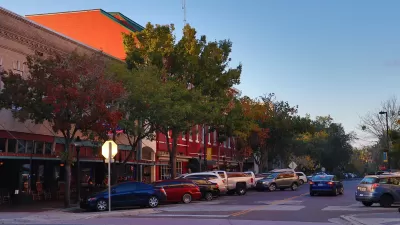Berkeley, California, pioneered exclusionary zoning in the early 1900s; with its new upzoning proposal, the city hopes to reverse that negative legacy and boost its housing supply by eliminating single-family zoning.

In 1916, Berkeley, California, became the first city to pass a single-family zoning law. But now, nearly a century later, the city is poised to reverse that historic — and consequential — decision, “joining other cities around the country overturning the regulations in a growing push to combat shortages and spur multifamily development,” according to a CoStar article by David Holtzman. The city council voted back in 2021 to begin the process of updating the city code to eliminate most of the city’s single-family zoning district and ”was on the cusp of approving plans last month … until a vote on the measure was delayed due to a procedural matter. But local officials expect the council to pass [the plan] in October,” the article reads. Under the new ordinance, 10 houses will be allowed per acre in the former single-family zoning district, while density in other zoning districts is expected to change to allow 20 houses per acre.
Single-family zoning refers to zoning policy that restricts development in an area to single family homes. Originally touted as a way to preserve home values and maintain public health and safety, the original measure was proposed by the developer of the Elmwood neighborhood, who wanted to preserve home values in his development by preventing Black families from moving into adjacent areas. Since then, it has a history of being used as a segregationist tool to control the demographics of an area, which — combined with minimum lot sizes — has prevented more affordable homes and multi-unit buildings on small lots, contributing to our current housing affordability crisis.
For more on the history and impacts of single-family zoning, check out our Planopedia article: What Is Single-Family Zoning?
“I’m not proud that Berkeley was the first city in the U.S. to pass single-family zoning,” Berkeley Mayor Jesse Arreguin said at the city council’s meeting last month, the CoStar article reports. “We see the outcomes to this day in racial disparities perpetuated by exclusionary zoning.”
“Berkeley, like other U.S. cities, is dealing with a local housing crunch, and it tweaked local zoning codes last year to allow for the construction of taller multifamily developments near the University of California, Berkeley, campus, potentially adding thousands of units,” Holtzman writes. The elimination of single-family zoning will also help Berkeley meet a state mandate to build 9,000 new homes by 2031.
The article acknowledges that “California technically ended single-family zoning statewide when Gov. Gavin Newsom passed legislation in 2022 that enabled single-family properties to be subdivided to allow up to four new houses on lots where only one was previously permitted. However, the law has resulted in limited new development thus far and has faced legal challenges from local governments.” The proposed plan in Berkeley will allow for even more density than state law requires. Once it is official, Berkeley will join the ranks of governments across the country that have abolished single-family zoning, including cities like Minneapolis, Sacramento, Austin, Charlotte, Portland, and Gainesville; counties like Arlington County, Virginia; and states like California and Vermont.
FULL STORY: First US City To Adopt Single-Family Zoning Set To Overturn It

Florida Considers Legalizing ADUs
Current state law allows — but doesn’t require — cities to permit accessory dwelling units in single-family residential neighborhoods.

Manufactured Crisis: Losing the Nation’s Largest Source of Unsubsidized Affordable Housing
Manufactured housing communities have long been an affordable housing option for millions of people living in the U.S., but that affordability is disappearing rapidly. How did we get here?

Americans May Be Stuck — But Why?
Americans are moving a lot less than they once did, and that is a problem. While Yoni Applebaum, in his highly-publicized article Stuck, gets the reasons badly wrong, it's still important to ask: why are we moving so much less than before?

EV Chargers Now Outnumber Gas Pumps by Nearly 50% in California
Fast chargers still lag behind amidst rapid growth.

Affordable Housing Renovations Halt Mid-Air Amidst DOGE Clawbacks
HUD may rescind over a billion dollars earmarked for green building upgrades.

Has Anyone at USDOT Read Donald Shoup?
USDOT employees, who are required to go back to the office, will receive free parking at the agency’s D.C. offices — flying in the face of a growing research body that calls for pricing parking at its real value.
Urban Design for Planners 1: Software Tools
This six-course series explores essential urban design concepts using open source software and equips planners with the tools they need to participate fully in the urban design process.
Planning for Universal Design
Learn the tools for implementing Universal Design in planning regulations.
City of Moreno Valley
Institute for Housing and Urban Development Studies (IHS)
City of Grandview
Harvard GSD Executive Education
NYU Wagner Graduate School of Public Service
City of Cambridge, Maryland
Newport County Development Council: Connect Greater Newport





























